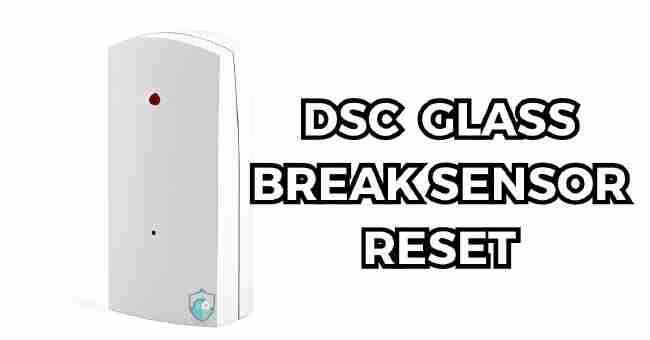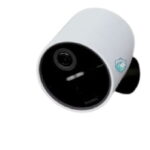Table of Contents
Do you wish to know how DSC glass break sensor reset works? Yes, resetting a DSC glass break sensor may vary depending on the make and model of the sensor.
I learned the hard way just how important properly functioning glass break sensors are.
Last year while on vacation, I got an alert in the middle of the night that a window sensor had been triggered in my home.
Watching the security footage, I saw an intruder break my back window and enter my home! Thankfully they fled once the alarm sounded, but it was still terrifying.
After this incident, I installed DSC glass break sensors so if a window breaks, I immediately know.
But recently one of the sensors got accidentally tripped, causing a false alarm.
That’s when I realized I needed to learn how to properly reset the DSC sensor to avoid future false alarms.
In this guide, we’ll walk through everything you need to know about resetting your DSC glass break sensor.
We’ll start with the basics – what is this device and why it’s important. Then we’ll get into some troubleshooting tips in case your sensor is malfunctioning.
Finally, we’ll provide step-by-step instructions for resetting various models of DSC glass break sensors.
Whether you’re a new homeowner getting familiar with your security system or you’ve lived in your house for years, this guide will help ensure your DSC glass break sensor continues working properly for years to come.
Let’s get started!
What Is a DSC Glass Break Sensor?
Before we learn how to reset a DSC glass break sensor, it helps to understand what exactly this device does.
DSC glass break sensors are security devices used to detect the sound of breaking glass.
They are typically mounted on walls or ceilings and can protect both homes and businesses.
These sensors use a few different technologies to pick up on the specific frequencies and vibrations that occur when glass shatters:
- Acoustic sensors listen for high-frequency sound waves.
- Microphonic sensors detect vibrations transmitted through walls/ceilings.
- Infrasonic sensors pick up low-frequency sound waves.
When the DSC glass break sensor recognizes that glass has shattered, it sends an alarm signal to the security system control panel.
This triggers the system alarm to scare off intruders and alert homeowners that a window or door nearby has been broken.
Why DSC Glass Break Sensor Reset is Required?
After your DSC glass break sensor has been triggered, it’s important to reset it to prevent false alarms.
Here’s why:
- The sensor enters “tamper-resistant” mode after being tripped. This prevents it from being accidentally reset, avoiding false alarms.
- To take the sensor out of tamper-resistant mode, you need to manually reset it per the device instructions.
- Resetting returns the sensor to active monitoring mode so it can detect future glass breaks.
Now let’s look at the step-by-step process for safely resetting your DSC glass break sensor without triggering the alarm.
How to Reset DSC Glass Break Sensors
The specific steps to reset your DSC glass break sensor will vary slightly depending on the model you have. But the general process is the same:
Step 1: Locate the Reset Button
Begin by finding the small reset button on your sensor. This is typically found on the back or bottom of the device. It may be labeled or just a small circular button.
Step 2: Disarm the System and Remove the Tamper-Resistant Screw
You’ll want to disarm your alarm system before resetting the sensor. Then locate and remove the tamper-resistant screw next to the reset button. This prevents accidental resets.
Step 3: Press and Hold the Reset Button
With the screw removed, press and hold the reset button for 5-10 seconds. On some models, you’ll see an LED indicator light flash when reset mode is activated.
Step 4: Replace the Tamper Screw and Test the Sensor
Release the reset button, replace the tamper screw, and test that the sensor is armed and functioning. Make loud noises near the sensor and verify the system alarm is triggered.
Step 5: Troubleshooting Tips
If the sensor doesn’t trigger the alarm during testing, repeat the reset process. Or try the troubleshooting tips in the next section.
And that’s it! Most DSC glass break sensor resets are quick and straightforward using these steps. Now let’s look at troubleshooting solutions for some common sensor issues.
Troubleshooting Your DSC Glass Break Sensor
While DSC glass break sensors are generally reliable, you may run into problems occasionally.
Here are some troubleshooting tips for common sensor issues:
Problem: False Alarms
DSC glass break sensors can be triggered by loud noises like thunder, fireworks, construction, or heavy traffic.
Pet activity and vibrations from doors/windows opening can also set off false alarms.
Solution:
- Adjust the sensor sensitivity to avoid false alarms while still detecting glass breaks.
- Relocate the sensor away from frequent vibrations or loud noises.
Problem: Sensor Not Detecting Glass Breaks
A DSC glass break sensor that doesn’t activate upon actual glass breaking could indicate an issue. Things to check:
Solution:
- Inspect the batteries and replace if needed.
- Test the sensor positioning and angle to ensure proper coverage.
- Adjust the detection sensitivity if it’s set too low.
Problem: Sensor Not Communicating with System
If the sensor doesn’t trigger the system alarm when glass breaks, there may be a communication issue.
Solution:
- Check and replace sensor batteries if needed.
- Ensure the sensor has adequate signal strength/range.
- Make sure the sensor placement doesn’t block wireless signals.
For any problem not resolved with basic troubleshooting, contact a security professional for assistance.
Now let’s look at an important sensor maintenance task – battery replacement.
Replacing DSC Glass Break Sensor Battery
DSC glass break sensors typically use long-life lithium batteries. However, replace these batteries every 5-10 years, even if the sensor isn’t used often.
Here are the steps to safely replace the battery:
Step 1: Locate the Battery Compartment
Find the battery compartment on the back or underside of the sensor. It will have a small cover held in place by a tamper-resistant screw.
Step 2: Disarm System and Remove Tamper Screw
Disarm your system before changing the battery. Then remove the tamper screw from the battery compartment cover.
Step 3: Remove Old Battery and Insert New
Take out the old battery and insert the new one, orienting the positive and negative ends correctly.
Step 4: Close Cover and Replace Tamper Screw
Close the battery compartment cover and reinsert the tamper screw. Test the sensor to verify normal operation.
Proper battery maintenance keeps your DSC glass break sensor running optimally. Now let’s go over using the sensor’s test mode.
How To Test DSC Glass Break Sensor
DSC glass break sensors have a test mode that lets you verify proper operation. It’s a good idea to test sensors monthly.
Here’s how:
Step 1: Disarm System and Access Test Mode
Disarm the system. Then locate and hold down the sensor’s test button for 5-10 seconds until the LED light flashes, indicating test mode is active.
Step 2: Trigger the Sensor
In test mode, trigger the sensor with a loud noise like a firm hand clap. Stand back 6-10 feet when testing.
Step 3: Verify and Exit Test Mode
If the system alarm is triggered, the sensor passed the test. Disarm the system and release the test button to exit test mode.
Regular sensor testing provides peace of mind that your DSC glass break sensor is working properly to detect intruders. Next, let’s go over adjusting the sensor’s detection sensitivity.
Adjusting DSC Glass Break Sensor’s Sensitivity
DSC glass break sensors have adjustable sensitivity so you can reduce false alarms while still detecting glass breaks. Here’s how to tweak your sensor settings:
Step 1: Locate Sensitivity Control
Find the sensitivity control potentiometer, typically located on the sensor’s back or bottom. It can be adjusted with a small screwdriver.
Step 2: Adjust Sensitivity and Test
Turn the potentiometer clockwise to increase sensitivity, counter-clockwise to decrease it. Trigger the sensor and adjust until the desired sensitivity level is achieved.
Step 3: Mount Sensor and Exit Adjustment Mode
Once the optimal sensitivity is dialed in based on your testing, mount the sensor in its permanent location and exit adjustment mode.
Adjusting the detection sensitivity prevents unnecessary false alarms without compromising security monitoring – giving you maximum peace of mind.
Models of DSC Glass Break Sensors
Now that we’ve covered general DSC glass break sensor reset, troubleshooting, and maintenance, let’s go over the steps for some specific models.
Here are the most popular DSC glass break sensors and how to reset them:
DSC PGX938 Glassbreak Detector
The DSC PGX938 is a reliable acoustic glass break sensor suitable for home use. Follow these steps to reset:
- Slide the tamper switch on the sensor’s back to the “Bypass” position.
- Locate the recessed reset button and use a paper clip to press and hold for 2 seconds.
- The LED light will flash when reset mode activates.
- Slide the tamper switch back to the “Secure” position.
- Test the sensor to verify normal operation.
DSC PG9984P PowerG PIR Motion Detector with Glassbreak
The PG9984P combines motion sensing and glass break detection. To reset:
- Remove the tamper screw from the sensor bottom.
- Press and hold the recessed reset button for 5 seconds.
- The LED light will flash, indicating successful reset.
- Replace the tamper screw and test the sensor.
DSC LC-171 Shock Glassbreak Sensor
The DSC LC-171 detects glass breaks up to 20 feet away. Follow these steps to reset:
- Remove the front cover and locate the reset button.
- Press and hold the reset button for 3 seconds until the LED flashes.
- Replace the front cover and test the sensor.
DSC WLS912L-433 Wireless Glassbreak Detector
The WLS912L-433 is a wireless glassbreak sensor with pet immunity. To reset:
- Remove the battery cover on the sensor rear.
- Press and hold the reset button for 5 seconds until the LED blinks.
- Replace the battery cover and test sensor operation.
Hopefully this overview gives you the key steps for resetting your specific DSC glass break sensor model and getting it back up and running.
Tips for Resetting and Maintaining Your Sensor
Before we wrap up, here are some handy tips and reminders for successfully resetting and maintaining your DSC glass break sensor:
- Always disarm your alarm system before resetting or maintaining the sensor to avoid false alarms.
- Consult your sensor manual if unsure of the reset process or troubleshooting steps.
- Test sensors regularly per the manufacturer’s recommendations (typically monthly).
- Replace lithium batteries every 5-10 years – use the correct replacement battery type.
- Clean sensors occasionally with compressed air to remove dust, dirt, and cobwebs.
- Avoid cleaning sensors with liquids or chemicals that could damage components.
- Ensure sensors are mounted properly for optimal coverage and positioning.
- Adjust sensitivity levels to balance security protection and false alarm avoidance.
Following these tips will keep your DSC glass break sensor working right for many years. And you’ll have confidence it will reliably detect intrusions.
Frequently Asked Questions About DSC Glass Break Sensors
Below are answers to some common questions homeowners have about DSC glass break sensors:
What’s The Detection Range Of Dsc Glass Break Sensors?
Most models can detect breaking glass within a 20-25 foot radius in optimal conditions. Range can vary based on room acoustics, mounting location, and sensitivity settings.
How Often Should The Glass Break Sensor Battery Be Replaced?
Plan on replacing the lithium battery every 5-10 years for optimal performance. Check manufacturer guidelines for your specific model’s battery life expectancy.
Can Dsc Glass Break Sensors Get Wet?
Avoid exposing these sensors to moisture. Water damage can permanently damage sensor components and electronics.
How Do I Clean My Dsc Glass Break Sensor?
Use compressed air to blow out dust and debris. Avoid using liquid cleaners or harsh chemicals on the sensor housing or microphone.
What’s The Best Placement For Dsc Glass Break Sensors?
Mount them high on walls/ceilings for a wide coverage area. Avoid windows, doors, speaker locations, and other sources of vibration or noise that could cause false alarms.
Do Glass Break Sensors Work Through Walls?
Yes, glass break sensors can work through walls. However, the effectiveness of the sensor will decrease depending on the thickness and material of the wall.
For best results, install glass break sensors on the inside of the walls that you want to protect.
Do Glass Break Sensors Work In Stay Mode?
Yes, most glass break sensors will work in stay mode. Stay mode is a setting on most alarm systems that allows the alarm to trigger even when the system is disarmed.
This is useful for protecting your home or business from break-ins while you are home.
Does A Glass Break Sensor Need To Face The Window?
No, a glass break sensor does not need to face the window. Glass break sensors are omnidirectional, meaning that they can detect breaking glass from all angles.
However, it is generally best to install glass break sensors on the walls that you want to protect, as this will provide the best coverage.
How Do I Turn Off The Beeping Sound On My Glass Break Sensor?
There will be an option in the control panel settings to enable/disable the local audible alarm sounder in the sensor.
Comparison Table: DSC Glass Break Sensors
| Model | Detection Range | Power Source | Frequency |
|---|---|---|---|
| PGX938 | Up to 20 ft | Battery | Acoustic |
| PG9984P | Up to 25 ft | Hardwired | Dual Acoustic & Microphonic |
| LC-171 | Up to 20 ft | Battery | Shock/vibration |
| WLS912L-433 | Up to 25 ft | Battery | Acoustic |
This table compares key specs for the most common DSC glass break sensor models.
Knowing your specific sensor’s features helps ensure you’re getting the most out of its capabilities.
Helpful Tips for DIY Security System Installation
Installing a security system yourself can save money compared to professional installation.
Here are some tips for a successful DIY install:
- Review the full system installation manual and all component instructions.
- Check that your wireless sensors maintain adequate signal strength from the proposed control panel location.
- Mount all sensors and contacts securely using the provided hardware.
- Pay close attention to glass break sensor placement recommendations.
- Take time positioning motion detectors to optimize coverage areas and avoid false triggers.
- Always use tamper-resistant mounting hardware where provided.
- Test that all security system components are operational and communicating properly after install.
- Change default passcodes to personalized codes you’ll remember.
- Review control panel settings and make sensitivity adjustments according to your space.
With careful planning and attention to detail, you can DIY a DSC system install and save significantly on security equipment costs. Just take it slow and double check your work.
Conclusion
I hope this guide has helped demystify the DSC glass break sensor and provided the information you need to reset and maintain it properly.
Here’s a quick summary of what we covered:
- What DSC glass break sensors are and how they work
- Why it’s important to periodically reset your sensor
- General steps for safely resetting sensors
- Troubleshooting solutions for common sensor issues
- How to replace the sensor battery
- Using the sensor test mode to verify functionality
- Adjusting the glass break detection sensitivity
- Resetting steps for popular DSC sensor models
- Tips for ongoing sensor maintenance and testing
With a bit of DIY work, you can easily keep your DSC glass break sensor running optimally for years of reliable security monitoring. And you’ll have confidence knowing your sensor will detect the sound of breaking glass and alert you to intrusions.
For additional sensor help or questions, don’t hesitate to contact a professional security installer. They can ensure your DSC system and all components are functioning as intended.
Stay safe and secure!





Pingback: How To Disable Glass Break Sensor -